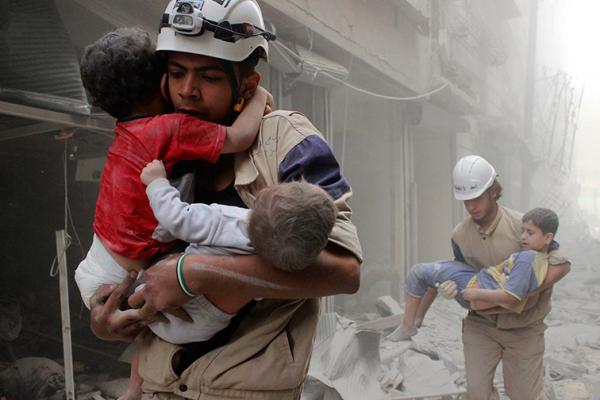“IF THERE IS A SHELLING, stay away from the windows and crouch next to a sturdy piece of furniture—like a bed or a wardrobe.”
“In the case of a bombing, cover your head with your hands and scream for help.”
Although they read like lines from an emergency-preparedness instruction manual, these are actually from a children’s coloring book. The book follows Mahr, a little boy with big brown eyes and a bowl-shaped haircut, and “Bebo, the Puppy”—a slightly obese, striped orange dog—through a series of emergency situations, the kind that have been all too common in Syria.
“Just fold your hands over your head, like Mahr and Bebo, the Puppy.”
The book is illustrated, written, and distributed by Syria Civil Defense—a group of 2,600 volunteer rescue workers, renowned for saving civilians from explosions and barrel bombings in opposition-controlled Syria. The book is intended to instruct children, in a playful yet serious way, how to act during barrel bombings and shellings, which have become a part of daily life in Syria.
Mahr crouches next to a wardrobe during a shelling. After a barrel bombing, Bebo folds his paws over his floppy, cartoonish ears and screams for help. The wardrobe—another character in this Brave Little Toaster-like adaptation of a child’s perspective of the Syrian civil war—smiles down at both of them.
“Don’t worry—the civil defense is on its way.”
Although the Syrian revolution began as a nonviolent movement, inspired by the Arab uprisings in 2011, the Assad regime’s brutal and almost immediate crackdown on the demonstrations quickly escalated the protests into an armed revolt and, eventually, a civil war. Some protesters began to take up arms in self-defense, joined by defectors from the regime’s army, and later foreign fighters—forming what would become known as the Free Syrian Army (FSA), engaging in guerrilla-style military tactics to challenge the Assad regime.
Near the end of 2012, the Assad regime pulled out of now opposition-controlled areas, taking with it basic government services—including fire response, civil administration, and schools. Without these institutions in place, and the first lines of the civil war officially drawn, the regime began to attack these areas at will, first showering them with mortar shells and then dropping barrel bombs—previously unseen weapons built from metal barrels filled with explosives, shrapnel, and sometimes gas, then dropped at random from helicopters and airplanes. Throughout the war, such weapons have exploded buildings and leveled neighborhoods, killing civilians either in the initial blast or underneath the remaining rubble.
At first, volunteers would rush out of their homes after each bombing and search for people who were still alive, stuck under the rubble. With no training or equipment, many were killed, often in “double taps,” a tactic of the Assad regime that involves waiting 15 minutes after a barrel bombing to drop another, often—perhaps intentionally—killing rescue workers in the process.
It was around this time that James Le Mesurier, then running good governance and democratization workshops in southern Turkey, met a member of Turkey’s earthquake response team in a bar. After a short conversation, Le Mesurier wondered whether earthquake response tactics that removed survivors from collapsed buildings could also be used to save people trapped under buildings collapsed from barrel bombs. With international funding allocated for “nonlethal aid” to the Syrian opposition (including more than $13 million from the U.S. State Department) and nothing to lose, Le Mesurier invited several members of the budding civil defense team in Syria to a pilot program in southern Turkey—a training that applied earthquake rescue tactics to war.
The next week, Le Mesurier received a call from one of the members of the Aleppo-based team: “Holy f***! This weekend we saved a husband, a wife, and a baby.”
Soon after, a regular training program was implemented—basic rescue training programs were held at the centers in Syria, followed by a more advanced training in Turkey and Jordan. Donor-purchased medical supplies, tools, and other paraphernalia were sent with workers back into Syria. Bullet-hole-ridden empty trucks and buses were reappropriated as ambulances and firetrucks. The signature white helmets, which earned Syria Civil Defense its nickname “the White Helmets” (though white just happened to be the cheapest color), were painted with “al-Defa3 al-Madani,” the Arabic phrase for civil defense, and taken across the border.
Beginning in 2013, equipped and in uniform, Syria Civil Defense members were now able to rush to the site of bombings, shouting: “Defa3 al-Madani, hada houn?” (“Civil defense! Anyone here?”)
The most dangerous job in the world
Syria Civil Defense now consists of 110 teams across the country and has saved an estimated 22,600 lives. Born from the chaos of the Syrian civil war, one of its first and most important values was impartiality. Despite the fact that they were based in the opposition-controlled areas, one of their first promises was to save anyone—regardless of their political allegiance. Although most of those in need of rescue are trapped beneath barrel bomb rubble in opposition-controlled areas, Syria Civil Defense workers have also saved people injured by FSA snipers, regardless of whether or not they are aligned with the regime.
“Our goal was to save as many people as we could in a short amount of time,” Gardenia (the preferred pseudonym of one of the founders of Syria Civil Defense) told Sojourners. “We don’t care who they are.”
Although the civil defense training and expertise have saved thousands of lives, there are equally as many instances when they are too late, and unable to respond in time, which takes a psychological toll on the workers.
“I have never rescued someone who was still alive; they have all been dead,” Gardenia continued, confessing the more difficult aspects of working as a volunteer medical relief worker inside of Syria. “One time a sniper shot someone who was walking right beside me,” she said. “The whole street was controlled by snipers, and you couldn’t walk from here to there without risking being shot.” Although she checked his vital signs and tried to resuscitate him, it was too late. He had been shot in the heart.
“One day I asked one of my colleagues why you would rush to save someone when you have mortars raining down on you or snipers firing at you,” she continued. He responded, “It is because I cannot think.”
The job itself has claimed the lives of more than 100 rescue workers—often while saving people between bombings. While double-tap bombings used to be a predictably spaced 15 minutes apart, allowing rescue workers an allotted period of time to save as many people as possible, in recent months these second strikes have been less predictable, which makes a difference in whether or not rescue workers can save lives and be safe while doing it.
“It has been called the most dangerous job in the world,” Le Mesurier said. “No one has challenged that statement.”
“Whoever saves a life ... ”
Although the rescue workers have adopted a Quranic sura as their motto—“Whoever saves a life, it will be as if [they have] saved all of humanity”—many are careful to emphasize that it is humanity, not religion, that guides their actions.
“I have asked all of them, when you see a resident sitting there after a bombing, do you rush there because God told you to, or because something inside of you pushed you there?” Ola Suliman, a training coordinator for Mayday Rescue, the organization formed to coordinate disaster-response trainings for Syria Civil Defense, told Sojourners. “All of them—all of them—have told me, no, of course not—it’s something inside.”
Reflective of Syrian civil society, most civil defense rescue workers religiously identify as Sunni Muslims—though there is a smattering of Christian, Druze, and other religious minority representation. However, as religious, ethnic, and sectarian divisions have become increasingly politicized during the conflict, many workers are careful to emphasize that religious and political impartiality is more important to their work than is their particular religious affiliation.
Religion does play a role in the practical sense. Working in more conservative areas of Syria, where women wear traditional dress and do not wish to be handled by male rescue workers—especially when they have been in a private setting and are not properly attired—has created a unique need for female first responders.
“There was a young lady trapped, and she didn’t want a man to come and rescue her because she was not wearing proper clothing, and she was too shy,” Suliman told Sojourners, recounting an incident from Idlib, a province in the north. “Her family also would have had a problem with a man coming in to rescue her—it was a conservative community, a small village where everyone knows each other.” Luckily, two recently trained women arrived at the scene to rescue her and take her to the hospital.
“This incident made the community demand more women on the civil defense teams,” Suliman continued. “Women now do the live training, like everyone else—because they might need these skills, like everyone else. In the cases where a woman needs to be rescued, they are also the first ones who are called.”
Although only 65 members of 2,600-member Syria Civil Defense are women, they train and work alongside male rescue workers, often responding to the same emergencies. Institutions such as Syria Civil Defense and the demand for increased medical workers have created space for women to be active in civil society, training and organizing civilians to respond to medical emergencies.
“As a woman, what are you going to do?” Gardenia said. “You can’t pick up a weapon and go fight; this is even difficult for a man.” For this reason, Gardenia encourages women to involve themselves in civil society initiatives, like civil defense.
“For the women who have the courage, I always say to go to the civil defense and work with them,” Gardenia said. “I encourage them because this is the only way to help end this conflict. The international community sees Syria as ISIS, the Islamic State, and al-Nusra [a branch of al Qaeda operating in Syria], but no. The civil defense shows that there are a lot of people here helping, working in ways that people aren’t talking about.”
For many, Syria Civil Defense is a symbol of the humanity—and a very active civil society—that is often absent from media coverage of the Syrian civil war. “When I met these workers, they took me back to the original Syrian community,” Suliman said. “They gave me hope again in the Syrian people; they gave me hope that the Syrian people just want to live.”
Though frequently commended for their heroism, civil defense workers such as Gardenia hope that the dramatic actions the rescue workers are famous for—such as saving civilians trapped underneath the rubble of war and resuscitating people immediately after explosions—are only a temporary job description.
“I wish that this would stop—that the barrel bombs will stop and there will be a ceasefire,” she said. “I hope that someday the civil defenders will not be working in wars or revolutions, but that they will rebuild Syria.”
On the last page of the coloring book, there is a blank page—except for a line of pink Arabic writing at the top that simply reads: “Draw your vision for the future of Syria.”

Got something to say about what you're reading? We value your feedback!

